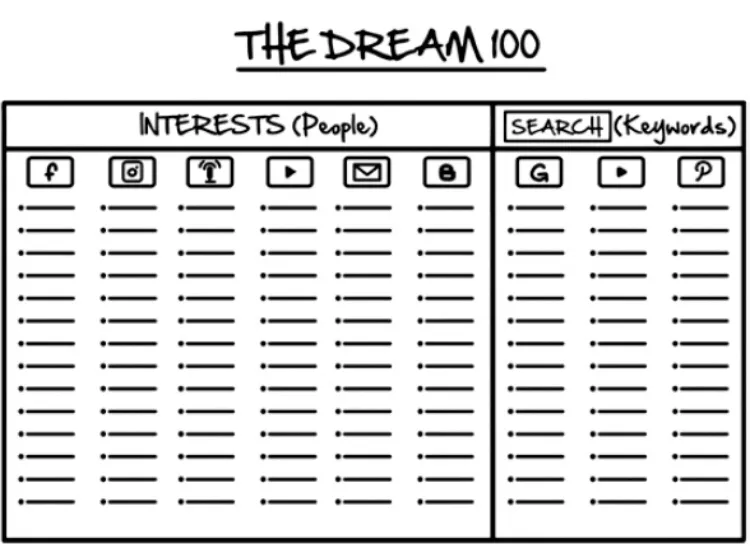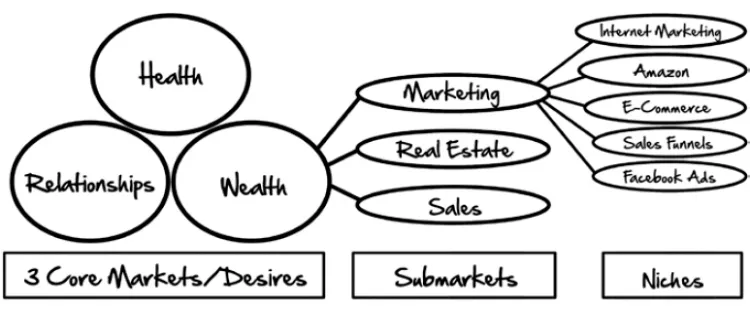Secret #2 Where Are They Hiding?
7 Min. Read Aug 18, 2025 #Traffic Secrets
One of the common misunderstandings with traffic is that you have to “create” traffic, but that just isn’t true. Traffic (your dream customer) is already there. Your job is to identify where they are, tap into those existing streams of traffic, throw out some hooks, and then get a percentage of your dream customers to start coming to you.
The Dream 100 (One to One)
Dream 100 for “One to One” selling strategy is powerful when your business model needs a small number of big customers.
Stop marketing to everybody and focus on the biggest buyers. Create one-to-one sales opportunities. The stategy includes sending out direct mail pieces with lumpy objects in them every two weeks and follow up on each package with a phone call. Twice a month mail a package, and twice a month make a call.
The biggest buyers are the hardest people to reach, you may need months to make a deal with one of them.
The Dream 100 (One to Many)
For most of us, we’re looking for lots of customers, not just 100.
The core strategy to understand is that your dream customers have already been congregated by online community influencers(Your Dream 100). If you focus on identifying them and marketing to them, your dream customers will start flowing into your funnels faster than by anything else you could do.
If you could build a relationship with one of the community influencers and get just one yes for helping promoting your business, that can turn into hundreds or thousands of new customers!
The Dream 100 strategy works even for those who didn’t respond or weren’t willing to promote your business. You are able to buy ads on platforms that are only shown to a commutiy owner’s audience.
Creating Your Dream 100 List
 The Dream 100 Worksheet
The Dream 100 Worksheet
The Dream 100 is the key foundation for traffic and the key foundation for your entire business because it helps you to figure out how to position your offers and tell your stories.
The Two Core Types of Congregations
Interest-Based Congregations
The first type of congregation is based on interests. In most social networks, after someone joins, the first thing the network tries to do is figure out what things you’re interested in. Platforms automatically track data points on each user, which is super annoying as a user but super awesome for advertisers.
On the Dream 100 worksheet, there’s a column for each of the main social networks. Depending on when you are reading this, there may be new networks that have become super popular and/or some of these networks may be dead, so you should adjust the columns as needed. What matters most is that you are making a list of all the people, companies, movements, and interests that your Dream 100 are already following.
Start with your favorite social network and try to write down between 20 to 100 Dream 100 names for that network. Then do the same thing for podcasts, blogs, email newsletters, and any other important types of congregation. Although we call this the Dream 100, you should try to make your list as big as possible, and re-create the list two to three times per year as you’ll pull off names that aren’t bringing the right customers and add new names as you find them.
Search-Based Congregations
When someone goes to Google or any other search platform, they type in a keyword phrase looking for something. As soon as they type a phrase, they enter an existing congregation of people searching for the same thing.
This type of congregation is called a search-based congregation, and searches can occur on Google, Yahoo, or any other search platform.
There will be many ways that we will refine and use these congregations, from buying ads to doing SEO to getting those people’s pages that are listed to push people into your funnels for you, but, for now, just build a list from your best guesses. We’ll discuss some amazing software tools in later chapters to help you identify phrases you might never have thought of on your own, and we’ll also explore how to find out how many people are searching for each phrase.
Where to Start?
You need to find 100 (or more) people because even with 100 people, you may only get 5 to 10 of them who are willing to let you get in front of their audience for free. After that, you may only get 10 or so others for whom you’re able to successfully target their audiences on the ad networks, so it’s essential that you cast a wide net.
The easiest way to build a larger list is using the 3 Core Markets or Desires.
 Inside of the 3 Core Markets/Desires are submarkets and niches.
Inside of the 3 Core Markets/Desires are submarkets and niches.
Each of the three markets have an unlimited number of submarkets. For example:
- Wealth → finance, investing, real estate, sales, marketing
- Health → nutrition, strength training, weight loss
- Relationships → marriage advice, dating advice, love
Inside each of the submarkets are the niches. So, for example, if your market is wealth, your submarket would be marketing, and the niche that you could create is “sales funnels.”
- Wealth → marketing → sales funnels
Your goal is to provide your Dream 100’s followers with your new opportunity. If you’re struggling to identify all the niches within your submarket, just ask yourself this question: What other vehicles are people trying to use to (insert result they desire) with (insert your submarket here)? For example:
- In the WEALTH core market with a real estate submarket: “What other vehicles are people trying to use to make money inside the real estate submarket?” The answers to these questions would include: house flipping, short sales, and wholesaling.
- In the HEALTH core market with a weight-loss submarket: “What other vehicles are people trying to use to get six-pack abs inside the weight loss submarket?” The answers to these questions would include: Keto diet, vegan diet, meatatarian diet, and bodybuilding.
- In the RELATIONSHIPS core market with a parenting submarket: “What other vehicles are people trying to use to have a better relationship with their kids inside the parenting submarket?” The answers to these questions would include: homeschooling, baby sign language, after-school sporting programs, and drama.
Each of these answers is a niche within a submarket with dozens of influencers, companies, and keywords that you can target! Your submarket is where you should focus all of your Dream 100 efforts initially because this is your warmest traffic.
A Different Dream 100 on Each Platform
People who are on Instagram love to consume content on Instagram, people who love to watch YouTube videos love to watch videos on YouTube, and people who listen to podcasts listen to podcasts.
People like to consume media in their own favorite ways, and while it’s possible to move people from one platform to another, but there is much less resistance when you just migrate people to you who are already on the platform that they love.
You’d better spend time and money focusing on the people who are already on that platform but not move them to another.
What about “Brick-and-Mortar”-Type Business?
For local brick-and-mortar business owners, the Dream 100 strategy still works. When building your Dream 100 list, instead of identifying the national influencers or leaders in your niche, you need to identify your local influencers.
For example, if you owned a local juice bar, you could ask yourself: Who is my dream customer and where are they already congregating? My dream customer would be someone who is trying to get healthier. To find these dream customers, you colud create a list of the local gyms, health food stores, chiropractors, personal trainers, nutritionists, etc., and then start building your Dream 100 from that list.